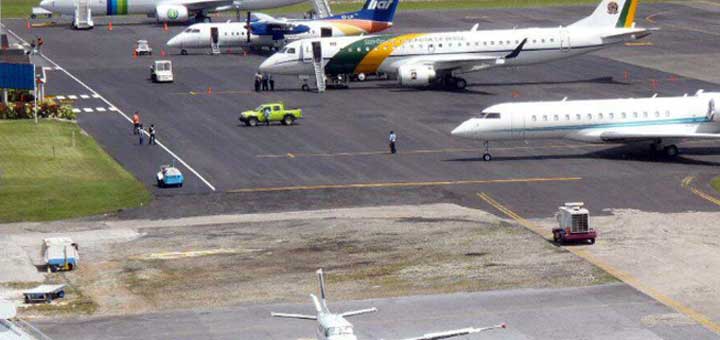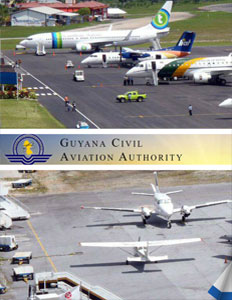Overseeing all air transportation services and facilities in Guyana
The Guyana Civil Aviation Authority (GCAA) was established in 2002 as a semi-autonomous body through the enactment of the Civil Aviation Act of 2000. Prior to that, the Authority was called the Civil Aviation Department and was part of the Ministry of Public Works and Communications. According to Chaitrani Heeralall, GCAA’s Director General, the Authority’s mandate is to oversee and regulate the aviation sector in Guyana and to provide all air navigation services. Previously, the department was responsible for airports and air navigation services, but had less regulatory responsibility. “Before, we were following the UK (United Kingdom) Air Navigation Order, with assistance from the UK Civil Aviation Authority,” Heeralall explains.
The GCAA was established to ensure that Guyana meets all international, aviation requirements and best practices standards promulgated by the International Civil Aviation Organization (ICAO), a UN-affiliated organization; to develop and promote the aviation industry; and to help improve the national economy. The Authority oversees all operation at the country’s two international airports – Cheddi Jagan, and Ogle, and all of its 85 hinterland airstrips.
The GCAA is divided into four Directorates: the Directorate of Air Navigation Services (ANS) is the largest and its role is operational. The ANS Directorate operates three divisions – Air Traffic Control Operations; Air Navigation Aids and Telecommunications; and Air Navigation Services Training. The Directorate of Air Transport Management is responsible for the economic regulation of commercial air services in Guyana. The Directorate of Aviation Safety Regulation is tasked with ensuring the safe conduct of all aviation activities in the Guyana airspace, and those conducted overseas by Guyana Air Operator Certificate Holders. The Directorate of Finance and Administration is responsible for all financial affairs, human resources development, and administrative matters of the GCAA.
In addition, the Director General of the Guyana Civil Aviation Authority has been tasked with establishing a Civil Aviation Security Unit (CASU) to ensure that all aviation stakeholders operating in Guyana comply with the required aviation security measures and practices contained in the country’s National Civil Aviation Security Program (NCASP) and other associated policy documents. CASU is also responsible for reviewing and approving existing and new aviation security programs for aircraft operators, airports, cargo companies or regulated agents, air navigation services, catering companies, AVSEC (Aviation Security) training organizations, AVSEC instructors, and other aviation security stakeholders.
This new division has been added to GCAA’s mandate due to the explosive growth of air traffic in the country over the preceding decade, and the potential threats all airports are exposed to. “The industry has grown significantly over the last ten years,” says Heeralall. “We have moved from having one international airport to two; in 2006, we had about 25 aircraft in our domestic fleet, owned by private aircraft owners and operators. At the moment, we have 60 aircraft in addition to which the generation of the fleet has changed significantly. Our international airport at Ogle, which is about 20 minutes from the city, is our hub for our domestic operations. Now, that airport has in excess of a hundred landings and departures every day.”
Heeralall relates that the international traffic that overflies Guyana’s airspace has increased, as well: “Guyana is strategically located to link the south and the north and provides a shorter route from some parts of Europe into South America. So, a couple of years ago, we enhanced our air space and provided additional services,” she says. In an effort to increase both safety and security, Heeralall states that, for the first time in its history, Guyana is going to install a state-of-the-art aeronautical surveillance system – the first country in the region to put it to use. “It will enhance safety; it will enhance our search and rescue capability; it will instill a lot more confidence in the aircraft operators and the airline industry. Something like that will tell them that we’re serious about aviation in Guyana,” she says.
Getting more serious about aviation is why Heeralall also stresses how important it is for the GCAA to work towards improving its international civil aviation compliance so that it can obtain an FAA (Federal Aviation Authority) Category 1 status. Under the International Convention on Civil Aviation (ICCA), each country is responsible for the safety oversight of its own air carriers. The United States FAA conducts the International Aviation Safety Assessment Program (IASA), assessing the Civil Aviation Authority of each country that has carriers operating to the United States. Category 1 means the air carriers from the assessed state may initiate or continue service to the United States in a normal manner and take part in reciprocal code-share arrangements with U.S. carriers. Currently, Guyana cannot initiate new service and is restricted to current levels of any existing service to the U.S., while corrective actions are underway.
An important part of achieving Category 1 status is have adequately trained and qualified technical personnel. Today, the GCAA has about 98 employees.
Heeralall explains the Authority’s training procedures: “For air navigation services, we have a training school. We hire persons with the required academic qualifications. We carry out their training to make sure we have certified air traffic controllers and maintenance personnel for that area. Some of those people have been trained in Canada, in the UK, in Trinidad & Tobago, and in Guyana. So, for our air traffic control staff, that’s where most of them have gotten their training; for our other technical officers – some of them have received training in the UK and in Guyana, and we have done a lot of our training in Singapore, by the UK CAA and the US FAA. We are also affiliated with the Caribbean Aviation Safety and Security Oversight System (CASSOS).” (CASSOS coordinates the sharing of the limited technical aviation expertise of the region, including training, licensing, certification and inspection procedures; and provides technical support to the participating States to enable them to achieve and maintain full compliance with international safety and security standards in keeping with their obligations as contracting States to the Convention on International Civil Aviation.)
In addition to working towards obtaining its Category 1 status, other important initiatives in GCAA’s immediate future include expansions of both international airports. The Cheddi Jagan expansion will be a government project, while work at Ogle will be a public/private partnership. “We’re having proposals from companies who want to start their operations at that airport, because it’s closer to the city,” Heeralall says. “We’re also working in collaboration with the aviation community for the rehabilitation and development of the hinterland airstrips. When we look back five years from now, I would like Guyana to see the GCAA as an organization that fostered the continued growth of a safe, secure, efficient aviation industry that contributes to the economic, social, and cultural well being of our nation.”
________________
AT A GLANCE
WHO: Guyana Civil Aviation Authority
WHAT: Overseer of all air transportation services and facilities in Guyana
WHERE: Georgetown, Guyana
WEBSITE: www.gcaa-gy.org
Preferred Partners
Air Services Ltd. – Located at the Ogle International Airport, Air Services Ltd. (ASL) operates an extensive fleet of 23 airplanes and 3 helicopters, providing safe, efficient, and reliable service to all of Guyana’s interior destinations. The company’s fixed wing fleet includes Cessna Grand Caravans, 206s, 172s, and a 414, BN2A Islanders, and a 510 Turbo Thrush Commander. Its rotor fleet includes Bell 206 L-4 and R-44 Helicopters. ASL’s shuttle operations are located at Mahdia where it moves over 300,000 lbs. of cargo and passengers per month to the remote hinterland airstrips in Regions 7 and 8, providing a lifeline to the communities in these two regions that are without river or road access. ASL has also partnered with the Ministry of Health to provide night medivacs which save numerous lives each year and this service is available to both corporate clients and the general public.
Committed to the development of Guyana’s tourism industry, ASL has partnered with the Ministry of Tourism to offer flights to the majestic Kaieteur Falls. The company is also a sponsor of the Pakaraima Safari. It has served production clients such as BBC, National Geographic, Discovery Channel, RAW TV and Omni Productions for over two decades.
ASL’s Maintenance Department is approved by the Guyana Civil Aviation Authority (GCAA) as an Aircraft Maintenance Organization (AMO) and its internationally recognized flight school offers courses from the Private Pilot to the Commercial Pilot license and includes a classroom consisting of the most modern teaching aids, a flight simulator, three (3) Cessna 172s and two (2) Cessna 206s. The school is staffed by seasoned flight instructors with thousands of hours of flight instructing experience. – www.aslgy.com
Trans Guyana Airways Ltd. – www.transguyana.net



 This information will never be shared to third parties
This information will never be shared to third parties